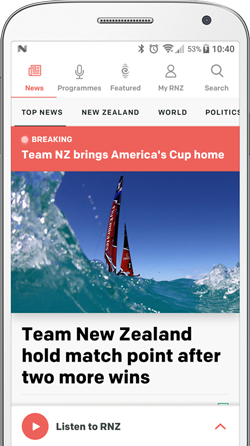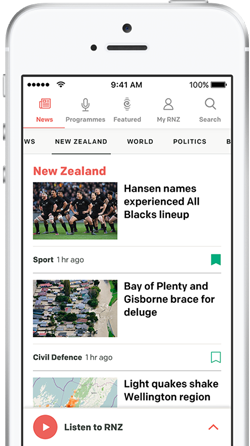
Winston Peters. Photo: RNZ / Reece Baker
Minister for Rail Winston Peters has hit back at Labour's suggestion he bears some responsibility for the ferry fracas, saying what he ordered in 2020 was not what Labour ended up trying to build.
Peters on Monday revealed the coalition government's replacement Interislander ferry plan, which he said would be "billions of dollars cheaper" than Labour's iReX project, which the government canned in December 2023.
The new Interislander ferries being delivered in 2029 will be about 200m long, 28m wide and be rail-capable, Peters said - about 20m shorter and two metres thinner than the original plan.
Peters said marine infrastructure in Picton would be replaced, but Wellington's will be modified and reused, not rebuilt. Most of the cost blowout in the iReX plan was due to infrastructure upgrades required to service the larger ships.
Speaking to Morning Report on Tuesday, Peters said it was "massive saving because they were going to build, as I said, a Taj Mahal in Picton and a Sydney Opera House in Wellington, and we couldn't afford it".
"What we're gonna do is we use as much as we can as in Wellington… We have to rebuild in Picton. And we'll have brand new ferries for the next 30 years underway."
The new ferries would be neither cheap Toyotas nor fancy Ferraris, but a "Porsche that can do the job", he said.
Though who will build the new ferries was not yet known, Peters said they would be sailing the Cook Strait from 2029. The original plan, developed when Peters was minister of rail in the Labour-led government of 2017-2020, had them in service from 2026.
Hyundai, the original firm contracted to build the ferries - which stood to make hundreds of millions of dollars in break fees - was in the running to build the new ones.
"That's one of the competitors, but as I say, we're not even telling the competitors who's in the mix here because we want to ensure - it's like, sound commercial practice," Peters said.
"It's sound business. You don't let the other person know what you're thinking, otherwise they've got the edge on you. Our job is to be smart and wise and go on to do what our forefathers did - go and buy a couple of good ferries for the job and get on with it."

Chris Hipkins. Photo: RNZ / Samuel Rillstone
After Monday's announcement, Labour leader Chris Hipkins said perhaps ordering the larger ferries was a mistake - but it was Peters' mistake too.
"With the benefit of 2020 hindsight, accepting Winston Peters' recommendation that we should go for two mega ferries in the first place probably wasn't the wisest decision.
"Two smaller ferries, which is where the Government has landed now, might have been better from the outset - that wasn't what Winston Peters recommended."
The original business case for the iReX project in 2018 put its cost at $775 million. By November 2019 that estimate had risen to almost $1.4 billion.
In May 2020, Peters - then minister of state-owned enterprises - announced the government was seeking a preferred shipyard to build two new rail-enabled vessels. In a release, Peters talked up having "bigger, better ships" and decried previous governments' failure to invest in rail and related infrastructure.
A deal was struck with Hyundai in 2021, after Peters' and his New Zealand First party exited Parliament and Labour alone held the purse-strings. By February 2023 the estimated cost had risen to $2.6b, and by November that year, $3b - Kiwirail citing the expanding cost of building new terminals.
Hipkins said if the government's proposal on Monday was what Peters came up with "the first time round, we might not be having this conversation".
'Bare-faced lie'
Speaking to Morning Report, Labour transport spokesperson Tangi Utikere also placed the blame on Peters.
"It was Winston Peters who was involved in negotiating in the first place, the original ferry sizes. So that certainly must be something that's been difficult and I guess a bitter and hard pill that the new minister of rail has had to swallow."
Peters called that a "bare-faced lie".
"This is the first time anybody's ever said that," he told Morning Report.
"In May of 2020, I ordered two ferries at $401m to go into the mix in terms of what we were ordering... When I came back [into Parliament], it was heading towards 80 percent being on infrastructure, 20 percent being on these massive ferries and we were never going to be able to pay for it… That's the truth."
He said the $300m break fee the government might have to pay to Hyundai was a "misnomer".
"They're talking about $300m cost. No, it's going to be dramatically less than that. We're heading to under $200m already and we haven't even got going.

Tangi Utikere. Photo: RNZ / Samuel Rillstone
"So as we go forward, there will be serious savings for some of it is reusable in terms of purposing it for the project we're talking about now. So all-around it's a win… It was an appalling series of mistakes under the previous administration."
Peters was unable to say what the expected cost of the new ferries would be, saying that would "give the shipbuilder the advantage" in any negotiations.
"We know it's not going to blow out because we've got a competition going on here now, whereas the previous administration just went to one company - and that was a very, very sound company, by the way - but instead of ordering what was fit for purpose, they went and ordered these massive bigger ships, which required a massive infrastructure blowout.
"Who on Earth thought that what we were trying to buy in two ferries was going to end up where 80 percent of the cost, plus, was going to be on infrastructure? Nobody was told that. And Picton and Wellington could not afford that."
But he admitted Wellington and Picton ratepayers might be on the hook, but insisted it would be for less than under the old plan.
"Eighty percent of the previous government's plan to buy ferries was not about ferries. It was about infrastructure. They had a, here we go, 'We can rip the taxpayer off, we can rip the raise bars off. Let's do what we feel like,' and it just blew out. It was incomprehensible. That's the point. You cannot find anyone who knows anything about this business who supports what they previously did."
Finance Minister Nicola Willis earlier told First Up the original plans were "gold-plated" and "the absolute maximum possible", while the new plan was "the minimum viable".
"The last government's project involved really big ships, way bigger than anything that's been used at that port in Marlborough or Wellington before, so it required massive demolition and reconstruction. We're saving those costs, but New Zealand will still get new ships."
She insisted the total cost, even with sunk costs and break fees, would be cheaper than iReX.
Sign up for Ngā Pitopito Kōrero, a daily newsletter curated by our editors and delivered straight to your inbox every weekday.







